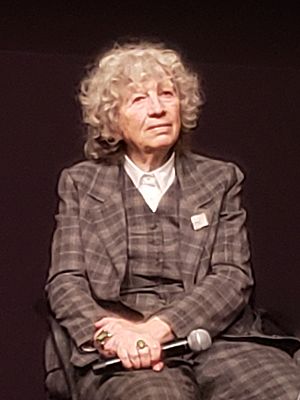Ulrike Ottinger facts for kids
Quick facts for kids
Ulrike Ottinger
|
|
|---|---|

Ulrike Ottinger in March 2019
|
|
| Born | 6 June 1942 |
| Occupation | Film director Screenwriter |
| Years active | 1973 – present |
Ulrike Ottinger (born 6 June 1942) is a German filmmaker and photographer. She is known for her unique and imaginative movies. Her films often explore different cultures and use very creative visual styles.
Early Life and Art Beginnings
Ulrike Ottinger started her artistic journey in 1959. She studied at the Academy of Arts in Munich. Her mother, Maria Weinberg, was a journalist. Her father, Ulrich Ottinger, was a painter.
From 1962 to 1968, Ottinger lived in Paris. She worked as a freelance artist there. She also studied etching with Johnny Friedlaender. During this time, her art was shown in several exhibitions.
Filmmaking Career
Ulrike Ottinger's films are special. They often challenge traditional movie styles. She creates new ways for viewers to enjoy what they see. Her movies are known for their strong artistic look and fantasy elements. They also explore different cultures, like a journey of discovery.
In 1966, she wrote her first movie script. It was called Die Mongolische Doppelschublade.
Ottinger returned to West Germany in 1969. She helped start a film club called "Visuell." She ran this club until 1972. She also managed an art gallery. There, she published works by modern artists.
During this time, she met Tabea Blumenschein and Magdalena Montezuma. Both actresses starred in her films starting in 1972. Ottinger developed her own unusual film style. Her movies often did not follow a straight story. Instead, they focused on long, detailed scenes. These scenes featured amazing and wild costumes. The costumes were often worn by female characters.
In 1983, she directed a play by Elfriede Jelinek in Stuttgart. She also designed the stage for it. In 1986, she did the same for another play in Graz. In 1989, her film Joan of Arc of Mongolia was shown. It was part of the 39th Berlin International Film Festival. Delphine Seyrig, who acted in many of Ottinger's films, was in it.
In 2003, Ottinger had a special art show in Chicago. It was called South East Passage. This work was like a travel diary. It showed her journey from Poland to the Black Sea. It also featured two cities: Odessa and Istanbul.
In 2009, her film The Korean Wedding Chest premiered in New York. The New York Times newspaper described her work. They said she was a unique artist in German cinema. Her films were long, detailed, and very creative.
Ottinger's films often show a love for Asian art styles. In later years, she made many documentaries. These films explored life in different parts of Asia. She planned to direct a horror-drama film called Die Blutgräfin. This movie was about the life of Elisabeth Bathory. However, the film was not made.
Other Creative Work
Besides filmmaking, Ottinger is also a talented photographer. She has worked as a lithographer, which is a type of printmaker. She is also a painter.
Ottinger has taught at The European Graduate School. Since 2019, she has been a member of the Academy of Motion Picture Arts and Sciences. This is the group that gives out the Academy Awards (Oscars).
Filmography
- 1972: Laokoon & Söhne (Laocoön & Sons)
- 1973: Berlin-Fieber (Documentary film about the Happening Berlin-Fieber by Wolf Vostell)
- 1975: The Enchantment of the Blue Sailors (Die Betörung der blauen Matrosen)
- 1976: VOAEX (Documentary film about the making of Wolf Vostell sculpture VOAEX in Spain)
- 1978: Madame X: An Absolute Ruler (Madame X – Eine absolute Herrscherin)
- 1979: Ticket of No Return (Bildnis einer Trinkerin)
- 1981: Freak Orlando
- 1984: Dorian Gray in the Mirror of the Yellow Press (Dorian Gray im Spiegel der Boulevardpresse)
- 1986: China. Die Künste – der Alltag (China. The Arts – the People)
- 1986: Sieben Frauen – Sieben Todsünden (Seven Women, Seven Sins)
- 1989: Joan of Arc of Mongolia
- 1990: Countdown
- 1992: Taiga
- 1997: Exil Shanghai (Exile Shanghai)
- 2002: Südostpassage (Southeast Passage)
- 2004: Zwölf Stühle (Twelve Chairs)
- 2007: Prater
- 2009: Still Moving (short)
- 2009: The Korean Wedding Chest
- 2011: Under Snow
- 2016: Chamisso's Shadow: A Journey to the Bering Sea in Three Chapters
- 2020: Paris Calligrammes
See also
- List of female film and television directors
- List of lesbian filmmakers
- List of LGBT-related films directed by women

